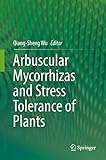Arbuscular Mycorrhizas and Stress Tolerance of Plants /
Mention d'édition :1st ed. 2017. Détails physiques : X, 327 pages 24 illustrations, 20 illustrations in color. ISBN :9789811041150.| Type de document | Site actuel | Cote | Statut | Date de retour prévue | Code à barres | Réservations |
|---|---|---|---|---|---|---|
| Livre | La bibliothèque des sciences de l'ingénieur | 631.46 WU (Parcourir l'étagère) | Disponible | 0000000035830 |
Chapter 1 Arbuscular Mycorrhizas: An Overview -- Chapter 2 Arbuscular Mycorrhizal Fungi and Tolerance of Drought Stress in Plants -- Chapter 3 Arbuscular Mycorrhizal Fungi and Tolerance of Waterlogging Stress in Plants -- Chapter 4 Arbuscular Mycorrhizal Fungi and Tolerance of Salt Stress in Plants -- Chapter 5 Arbuscular Mycorrhizal Fungi and Tolerance of P Stress in Plants -- Chapter 6 Arbuscular Mycorrhizal Fungi and Tolerance of Fe Stress in Plants -- Chapter 7 Arbuscular Mycorrhizal Fungi and Tolerance of Zn Stress in Plants -- Chapter 8 Arbuscular Mycorrhizal Fungi and Heavy Metal Tolerance in Plants -- Chapter 9 Arbuscular Mycorrhizal Fungi and Tolerance of Temperature stress in Plants -- Chapter.10 Roles of Arbuscular Mycorrhizal Fungi in Protecting against Plant/soil Pathogens -- Chapter 11 Arbuscular Mycorrhizas and Reactive OxygenSpecies -- Chapter 12 Arbuscular Mycorrhizas and Ecosystem Restoration -- Chapter 13 Application of Arbuscular Mycorrhizal Fungi into Agriculture.
This book reviews the potential mechanisms in arbuscular mycorrhizas (AMs), in the hope that this can help arbuscular mycorrhizal fungi (AMF) to be more used efficiently as a biostimulant to enhance stress tolerance in the host plants. AMF, as well as plants, are often exposed to all or many of the abiotic and biotic stresses, including extreme temperatures, pH, drought, water-logging, toxic metals and soil pathogens. Studies have indicated a quick response to these stresses involving several mechanisms, such as root morphological modification, reactive oxygen species change, osmotic adjustment, direct absorption of water by extraradical hyphae, up-regulated expression of relevant stressed genes, glomalin-related soil protein release, et cetera The underlying complex, multi-dimensional strategy is involved in morphological, physiological, biochemical, and molecular processes. The AMF responses are often associated with homeostatic regulation of the internal and external environment, and are therefore critical for plant health, survival and restoration in native ecosystems and good soil structure.


Il n'y a pas de commentaire pour ce document.